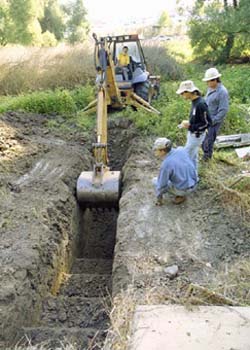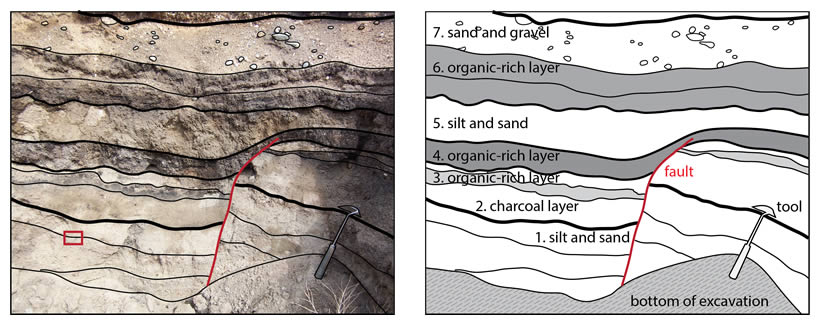Is California overdue for a large earthquake? Perhaps, but residents shouldn’t get complacent.
By Krystal Vasquez (@CaffeinatedKrys)
Citation: Vasquez, K., 2021, Overdue? The future of large earthquakes in California, Temblor, http://doi.org/10.32858/temblor.169

With hundreds of known faults running through the state, California is no stranger to earthquakes. In fact, one occurs about every three minutes, though the majority of these are too small to be felt. But even with all this seismic activity, the state’s three major fault lines have remained eerily quiet. Evidence shows that the San Andreas, San Jacinto and Hayward faults should produce a major earthquake roughly three or four times per century (Biasi and Scherer, 2019). Yet, the last one struck in 1918.
This might not seem like a bad thing. After all, no one wants to experience a big earthquake. But seismologists know that with each passing year, these faults will continue to accumulate stress. Eventually, this stress will be released through a major earthquake — or maybe even several of them. It’s not a matter of if, but rather when this will happen. And given the state’s unusual shortage of large earthquakes, one could easily surmise that California’s well overdue.
However, David Jackson, a geophysicist at the University of California, Los Angeles, is not quite convinced. “It may be just luck” that there has not been a major earthquake, he admits. Alternatively, there might be some unknown interaction between the fault lines that has gifted the state with a relatively peaceful century. But at the 2021 Seismological Society of America Annual Meeting today, Jackson advocated for another possibility: perhaps this so-called “anomalous hiatus” doesn’t actually exist.
Digging into Earth’s past
The oft-spoken phrase, “Those who do not learn history are doomed to repeat it,” applies to earthquakes, too. Studying California’s past earthquakes can help scientists get a better idea of how much shaking the state might see in the future.
They do this by digging trenches along active fault lines and searching for evidence of ground displacements or marks left behind on the shaken landscape. The gaps between these displacements tell a “micro-geologic story,” says Glenn Biasi, a geophysicist from the U.S. Geological Survey (USGS), who was not involved with the study. In other words, these trenches are used to reconstruct a timeline of past seismic events, which scientists can then use to calculate the likelihood that a major earthquake could occur within a subsequent time frame. 
That’s why scientists have dug numerous trenches along California faults. “We have 31 places where we think we know about past earthquakes,” Biasi explains. “Those places have not produced an earthquake in 100 years.” Based on the data from these locations, it turns out the likelihood that there would be no evidence of a major earthquake in these locations during this timeframe is extremely low. “Many of us think that must mean something.”
But in his presentation, Jackson casts some doubt on these “paleoseismological” studies. He says that not all earthquakes leave their marks and, on the flip side, “there may be other things that also give you a similar kind of displacement.” He specifically points to a study led by Nathan Onderdonk, a geologist at California State University, Long Beach, where Onderdonk concludes that one particular displacement might have been the result of a nearby earthquake or groundwater movement, among several other possibilities (Onderdonk et al., 2013). Based on this, Jackson argues that some displacements might be attributed to earthquakes even though weren’t actually caused by them. This would, in turn, cause scientists to overestimate the rate these events occurred in the past. “If, say the rate is only once a century or maybe once every 75 years, then if you go 100 years without having any event” our earthquake hiatus makes a lot more sense.
His main conclusion, though, is that large earthquakes never stopped occurring. By combining instrumental seismic data (e.g. seismographs) and personal accounts of shaking, Jackson points out that there have actually been nine magnitude-7.0 earthquakes in the state since 1918 — they just don’t show up in the paleoseismic records. Biasi, however, says that comparing these different types of data is like comparing “apples and oranges” and explains that paleoseismic data look at specific points on the fault line, whereas the data Jackson used describes a much broader area.
“We said that these [specific] sites on our biggest faults have a hiatus, not that there’s a general hiatus…These places haven’t broken in 100 years. Over there,” Biasi points to somewhere in the distance, “I don’t know.”

Don’t get complacent
It seems the jury might still be out on what this gap in the paleoseismic record might mean. Are the California fault lines overdue? Maybe. But maybe “overdue” is the wrong way to frame this question.
“The potential for strong shaking over most of California is real,” says Biasi, “and the probabilities are high enough that you can’t discount that it will happen in your lifetime.”
Similarly, Jackson ends his presentation with: “We don’t need the compelling word ‘overdue’ to compel action,” and separately says that he doesn’t want to be interpreted as saying there’s no danger. Instead, he offers the following advice: “Make a plan…and then every time you hear the word earthquake, or you feel an earthquake, look at your plan and make an improvement… If you hear the word earthquake, and you don’t do something, then you’re overdue.”
References
Biasi, G. P., & Scharer, K. M. (2019). The Current Unlikely Earthquake Hiatus at California’s Transform Boundary Paleoseismic Sites. Seismological Research Letters, 90(3), 1168-1176
Onderdonk, N. W., Rockwell, T. K., McGill, S. F., & Marliyani, G. I. (2013). Evidence for Seven Surface Ruptures in the Past 1600 Years on the Claremont Fault at Mystic Lake, Northern San Jacinto Fault Zone, California. Bulletin of the Seismological Society of America, 103(1), 519–541
- Earthquake science illuminates landslide behavior - June 13, 2025
- Destruction and Transformation: Lessons learned from the 2015 Gorkha, Nepal, earthquake - April 25, 2025
- Knock, knock, knocking on your door – the Julian earthquake in southern California issues reminder to be prepared - April 24, 2025
